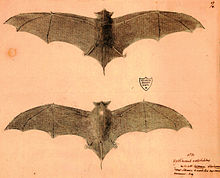Natal free-tailed bat
| Natal free-tailed bat | |
|---|---|

| |
Type illustration by Paul Jossigny from 1770
| |
| Scientific classification | |
| Domain: | Eukaryota |
| Kingdom: | Animalia |
| Phylum: | Chordata |
| Class: | Mammalia |
| Order: | Chiroptera |
| Family: | Molossidae |
| Genus: | Mormopterus |
| Subgenus: | Mormopterus
|
| Species: | M. acetabulosus
|
| Binomial name | |
| Mormopterus acetabulosus Hermann, 1804
| |
| Synonyms | |
| |
The Natal free-tailed bat (Mormopterus acetabulosus) is a species of bat in the family Molossidae, the free-tailed bats. It is endemic to the island of Mauritius. It is known from fewer than five locations in its range, but it is common at a few sites. It roosts in caves, and it is considered to be an endangered species due to disturbance of its cave habitat.[1]
Taxonomy and etymology
It was described as a new species in 1804 by French naturalist Johann Hermann. Hermann placed it in the genus Vespertilio.[2] In 2008, the Natal free-tailed bat was split into two taxa with the description of a new species, Mormopterus francoismoutoui. The species is called the "Natal" free-tailed bat because of another species Hermann described, Dysopes natalensis, named after the Natal Province of South Africa.
Dysopes natalensis was later
Description
The Natal free-tailed bat is a very small species of bat. Its upper lip is very wrinkled. Its ears are small and connected in the back by a thin interaural membrane. Males have a
Range and habitat
It is endemic to Mauritius. There is one "doubtful" record from Madagascar and two records from South Africa which may be vagrants.[1]
Conservation
As of 2017, it is listed as
References
- ^ . Retrieved 19 November 2021.
- ^ ISBN 9781408189962.
- .
- ISBN 0521866456.

